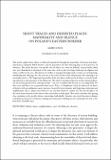Files in this item
Silent traces and absent places : materiality and silence on Poland's eastern border
Item metadata
| dc.contributor.author | Joyce, Aimée | |
| dc.date.accessioned | 2021-12-17T15:30:14Z | |
| dc.date.available | 2021-12-17T15:30:14Z | |
| dc.date.issued | 2021-12-14 | |
| dc.identifier | 277072594 | |
| dc.identifier | 79552bd3-a5e6-4212-8e69-6887d97f9990 | |
| dc.identifier.citation | Joyce , A 2021 , ' Silent traces and absent places : materiality and silence on Poland's eastern border ' , Ethnologia Polona , vol. 42 , pp. 33-48 . https://doi.org/10.23858/ethp.2021.42.2714 | en |
| dc.identifier.issn | 0137-4079 | |
| dc.identifier.other | ORCID: /0000-0002-9041-4826/work/105007158 | |
| dc.identifier.uri | https://hdl.handle.net/10023/24535 | |
| dc.description.abstract | This article explores how silence is held and transmitted through the materiality of deserted and abandoned places along the Polish frontier; and the generative role that silencing plays in local practices of tolerance. The article discusses two specific sites of silence in a town on Poland’s eastern border. Both sites were abandoned or destroyed at the same time, and are part of a larger landscape of religious and ethnic conflict in the area. This history of conflict is managed through small everyday acts of forgetting, minimising and silencing. Yet, the two sites at the centre of this article demonstrate that silencing is an incomplete process. The fragmented materiality of the two places undercuts local silences, actively invoking experiences and memories of the Holocaust. The objects missing and present in these haunted places are too inconsequential to be considered ruins – one site is notable only because it is an empty field. Yet these sites and objects act as powerful silent traces. Traces, as Napolitano (2015) has observed, are knots of history with an ambiguous auratic presence, located between memory and forgetting, repression and amplification. Traces conjure that which we can and that which we cannot say. The deserted places of the town draw attention to the silences that conviviality is built upon. This article considers how paying close attention to the specific silences concerning ‘unthinkable’ histories can reveal the power relations embedded in the process of history making and community building not just nationally, but also at the local level (Trouillot 1995). | |
| dc.format.extent | 15 | |
| dc.format.extent | 114545 | |
| dc.language.iso | eng | |
| dc.relation.ispartof | Ethnologia Polona | en |
| dc.subject | Poland | en |
| dc.subject | Silence | en |
| dc.subject | Trace | en |
| dc.subject | The Holocaust | en |
| dc.subject | Absence | en |
| dc.subject | GN Anthropology | en |
| dc.subject | T-NDAS | en |
| dc.subject | SDG 16 - Peace, Justice and Strong Institutions | en |
| dc.subject | AC | en |
| dc.subject.lcc | GN | en |
| dc.title | Silent traces and absent places : materiality and silence on Poland's eastern border | en |
| dc.type | Journal article | en |
| dc.contributor.institution | University of St Andrews. Social Anthropology | en |
| dc.contributor.institution | University of St Andrews. Centre for Contemporary Art | en |
| dc.identifier.doi | https://doi.org/10.23858/ethp.2021.42.2714 | |
| dc.description.status | Peer reviewed | en |
This item appears in the following Collection(s)
Items in the St Andrews Research Repository are protected by copyright, with all rights reserved, unless otherwise indicated.

